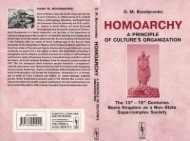L. Fituni, I. Abramova Resource Potential of Africa and Russia's ...
L. Fituni, I. Abramova Resource Potential of Africa and Russia's ...
L. Fituni, I. Abramova Resource Potential of Africa and Russia's ...
Create successful ePaper yourself
Turn your PDF publications into a flip-book with our unique Google optimized e-Paper software.
<strong>Africa</strong>n resources <strong>of</strong> cobalt represent another area <strong>of</strong> competition<br />
for <strong>Africa</strong>’s natural wealth. More than half the cobalt for heat–<br />
resistant <strong>and</strong> high-strength alloys <strong>and</strong> jet engines used in defense <strong>and</strong><br />
energy production in the U.S. <strong>and</strong> EU comes from <strong>Africa</strong>. Assessed<br />
by reference to the production <strong>of</strong> cobalt metal or cobalt chemicals<br />
from cobalt containing materials requiring further refining, was estimated<br />
at 56 400 tonnes in 2008. EU production accounted for 18% <strong>of</strong><br />
this total amount. The EU cobalt industry is sourcing all <strong>of</strong> its primary<br />
cobalt feed from outside the Community, with a strong reliance on<br />
<strong>Africa</strong>n <strong>and</strong> Russian producers as regards ores <strong>and</strong> metal.<br />
The United States has its own cobalt ore deposits, but most <strong>of</strong><br />
them are depleted <strong>and</strong> its further mining is proving too costly owing<br />
to which all cobalt for U.S. industry has been coming from other<br />
countries since 1971. Identified cobalt resources <strong>of</strong> the United States<br />
are estimated to be about 1 million tons, in Minnesota, Alaska, California,<br />
Idaho, Missouri, Montana, <strong>and</strong> Oregon.<br />
The vast majority <strong>of</strong> these resources are in nickel–bearing laterite<br />
deposits, with most <strong>of</strong> the rest occurring in nickel–copper sulfide<br />
deposits hosted in mafic <strong>and</strong> ultramafic rocks in Australia, Canada,<br />
<strong>and</strong> Russia, <strong>and</strong> in the sedimentary copper deposits <strong>of</strong> Congo (Kinshasa)<br />
<strong>and</strong> Zambia. In addition, as much as 1 billion tons <strong>of</strong> hypothetical<br />
<strong>and</strong> speculative cobalt resources may exist in manganese<br />
nodules <strong>and</strong> crusts on the ocean floor. 7<br />
Fifty-two percent <strong>of</strong> the world cobalt reserves are in the four <strong>Africa</strong>n<br />
countries – the Democratic Republic <strong>of</strong> Congo (DRC), Zambia,<br />
Morocco, <strong>and</strong> Botswana. The lion's share <strong>of</strong> the amount (60<br />
percent <strong>of</strong> all world production, excluding the former USSR) belongs<br />
to DRC, which alone provides 65 percent <strong>of</strong> the U.S. internal<br />
dem<strong>and</strong> for this metal.<br />
In 2001–2008, before the crisis, <strong>Africa</strong>'s share in the world production<br />
<strong>of</strong> purified metal was steadily falling (from 65 percent to 10<br />
percent) while its production in Europe <strong>and</strong> China was growing, but<br />
the main supplier <strong>of</strong> primary material was DRC as before. The main<br />
part <strong>of</strong> cobalt mined in DRC is exported to the U.S. <strong>and</strong> Europe.<br />
China meets a considerable proportion <strong>of</strong> its dem<strong>and</strong> from Zambia<br />
<strong>and</strong> Morocco.<br />
20







